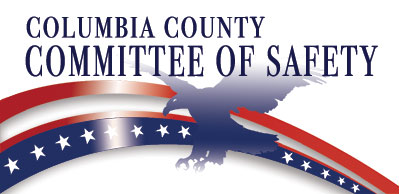What Is?
What Is A "Committee of Safety" ?
Our nation was founded through “Committees of Safety”, that were called the First and Second Continental Congresses, that led to our Declaration of Independence, our Constitution, and our Bill of Rights. In fact, all 56 signers of the Declaration of Independence were members of Committees of Safety in their home towns. The Committees of Safety were overtaken in the 1800’s by the Democrat and Republican parties.
Read below an excerpt of the role, authority, and actual events of a Committee of Safety. This record is from the King’s District Committee of Albany county of the colony of New York from 1776-1778.

Emerging Revolutionary War welcomes guest historian Kieran O’Keefe.
While the most famous scenes of the American Revolutionary War involve major battles or deliberations in Congress, the driving force behind the Revolution within small towns were committees of safety. As the war progressed and British authority dissipated, these committees became the effective government in most localities until the formal establishment of state governments. They had responsibilities such as regulating the economy, suppressing loyalists, procuring military supplies, raising revolutionary forces, and overseeing civil and criminal justice. Despite their ubiquity, it is rare to find the records of a committee completely intact. One such exception is the King’s District Committee of Albany County, New York, whose minutes survive in the Library of Congress.
The First Continental Congress created the committee system when it adopted the Continental Association in 1774. The Association called for the non-importation, non-consumption, and non-exportation of goods between the colonies and Great Britain, Ireland, and the British West Indies. This boycott was to put economic pressure on Britain to repeal the punitive Coercive Acts, which punished Massachusetts for the Boston Tea Party by closing the port of Boston and bringing the colony under tighter royal control with the aid of British redcoats. The Continental Association also stated that “a committee be chosen in every county, city, and town, by those who are qualified to vote for representatives in the legislature, whose business it shall be attentively to observe the conduct of all persons touching this association.” These committees were to ensure that all Americans adhered to the boycott stipulated in the Association. Committees began forming throughout the colonies in late 1774 and soon took on a greater role than originally designed, frequently seizing the reins of local government. The committees were unusually democratic. They generally consisted of about five men who were popularly elected, and many members were from the middling ranks of society with no prior political experience.
The King’s District Committee record book begins in May 1776, although there is evidence the committee first convened earlier than that. The body continued to meet until the spring of 1778. Located in what was then southeastern Albany County (today Columbia County), King’s District sat along the Massachusetts border and had been settled predominately by New Englanders during the 1750s. The town was formally established in 1772 when Albany County was divided into fifteen districts. In 1788, the community was renamed “Canaan” to remove royal vestiges from its name.
The most significant challenge the King’s District Committee faced was suppressing local Loyalists. On June 4, the committee adopted a resolution recommended by the New York Provincial Congress which asked all men within the community to sign a test where they swore to take up arms against Great Britain. If they refused, they would be disarmed, and their names added to a list of persons who did not sign. At about the same time, the committee disarmed the entire community of New Britain, a neighborhood within the district that was particularly sympathetic to the British. King’s District revolutionaries feared Loyalists would rise up in arms to undermine the Revolution. On August 23, 1776, the committee formally asserted its authority to investigate Loyalist matters, resolving that all committeemen had the “Power and authority to take up and Examain aney Person or Persons who By Enformation…shall Be sospectted to Be unfriendly to the States of america.”
The committee regularly investigated suspected Loyalist transgressions, which ranged from speaking out in favor of Great Britain, to enlisting men in the British service. Punishments also varied, but included fines, bonds for good behavior, property seizure, and imprisonment. In July 1776, Daniel Green appeared before the committee on the accusation of “unbecoming talk against the american Cause.” After hearing the evidence and finding him guilty, the committee ordered that he resign his militia commission and pay 25 shillings as a fine. In November 1776, Philip Alsworth was sent to jail for refusing to give evidence against other Loyalists, declaring that the king had the right to rule America, and that “america was Not able to stand [against] the king.” In January 1777, Jesse Bullis was likewise imprisoned for engaging men to serve the British. When William Alesworth was found to have spoken out against the Revolution, the committee ordered that he be confined to his farm, and that “if seen off from sd Farm he shall be liable to be shot by any Person that shall see him.” The committee also seized possession of his estate “for the use of the American States.” Loyalists who were imprisoned or driven from the community often had their property seized and rented to others. In February 1777, the committee took control of four Loyalist estates and leased the property, using the funds to support the cause.
Without a formal state government in place, the committee also became the executive, legislative, and judicial body for the town. In January 1778, after learning that various persons in the district had tippling houses, the committee resolved that no person could sell or retail liquor without a certificate from the committee. The committee also acted as the court of the town. In June 1776, the board held a formal trial when Ephraim Foot accused James Lockwood of “Feloniously Taking” his cow and heifer. After taking depositions from witnesses on both sides, they committee deliberated and concluded that Lockwood was guilty, and ordered he pay a fine. A year and a half later, the committee investigated Philip Vincent on the accusation that he had stolen a coverlet. Determining he was guilty, it was ordered that he be “whipt ten Lashes on the naked Body,” pay for the coverlet and the cost of the suit, and that he leave the district with his family within a month, otherwise he would be whipped ten lashes for every month he overstayed.
Issues of morality were additionally regulated by the committee. In August 1776, the board resolved that committeemen and militia officers had the power to stop and bring before the committee “all Persons found travling on the sabaath who cannot give a Reasonable account for their so Doing.” The committee also ruled on several cases of adultery, one of the most prominent examples taking place in October 1777. Hannah Capron was accused of leaving her husband and children, and on being brought before the board, she confessed her guilt. She said she had left her family and moved in with Joseph Simeon, with whom she had had a child. She added that Simeon was likewise married with children. The committee ordered that Capron be publicly whipped on the back with twenty lashes, that she “Be Branded with the Letter A on the forehead & wear a Rope round her Neck during Life & Liable to be whipt twenty Lashes” each time she was seen without the rope. If Simeon was also punished for adultery, it was not mentioned.
The committee system in New York continued until 1778. With the adoption of the state constitution in 1777, a formal governmental structure replaced committees by the following year. Some committees, including one in King’s District, would be revived in 1779, this time to deal primarily with the economic issues caused by the hyperinflation of continental currency. The last recorded meeting for the King’s District Committee was on April 20, 1778. The King’s District Committee records show that the committees took a far greater role than had ever been intended when it was created by the First Continental Congress. Given that it is relatively rare to have such detailed committee minutes intact, this item is a unique source that offers insight into how the war affected small communities.

*Sources*
King’s District Committee of Safety and Protection Record Book 1776-1778, Library of Congress Manuscript Division Washington, D.C.
T.H. Breen, American Insurgents, American Patriots: The Revolution of the People (New York: Hill and Wang, 2011)
Edward Countryman, A People in Revolution: The American Revolution and Political Society in New York, 1760-1790 (Baltimore: Johns Hopkins University Press, 1981; New York: W.W. Norton, 1989)
Biography:
Kieran O’Keefe is a Ph.D. candidate at The George Washington University. His dissertation examines Loyalists in the Hudson River Valley, exploring how conflict, upheaval, and forced migration to Canada shaped the community during and after the war. Prior to attending George Washington, he received his M.A. from the University of Vermont and his B.A. from Mount Saint Mary College.
